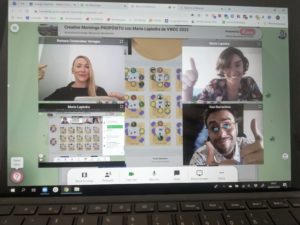Universities and organisations continue to transition learning and event operations to the virtual space, but often we do not consider inclusion as an element in our virtual activities. But as I like to say, this is of utmost importance because “without inclusion, no real impact in the virtual classroom” and this is my learning concept which I call IMPLUSION = IMPACT + INCLUSION.
This blog article summarises the main points from a LinkedIn Live with Shilpa Subramaniam (Co-founder and Director at The Learning Gym Ltd.) and Barbara Covarrubias Venegas (Founder #virtualspacehero) about designing and facilitating inclusive, virtual training programs.

Shilpa Subramaniam is an expert in Learning Design & Transfer.
Experienced Organizational Development Specialist with a demonstrated history of working across industries and levels. Skilled in Talent Management, HR Consulting, Personnel Management, Business Development, and Employee Engagement. Designs and delivers learning solutions. Psychology background with a MSc focused in International HRM and Comparative IR from Manchester Business School.
Connect with Shilpa on LinkedIn here
What are key elements to be considered before, during, and after a virtual training program?
“People often forget that elements of inclusion are already needed during the design phase of the program. Not only during its facilitation. Inclusion is a mindset. It’s not just a checklist. It means being constantly present to see what has changed and constantly evaluating if something that you planned on doing needs to be adapted to ensure that everyone feels included.” Shilpa Subramaniam
Keeping these words in mind, it gets quite obvious that we have to think about inclusion already before the start of the event. But exactly needs to be considered to ensure that your virtual training program will be inclusive?
Before the training
💡Find out what your design preferences/biases are: Working together with colleagues can open your eyes in this regard. It’s human to have preferences and biases. But it’s important to be aware of them and to constantly challenge these preferences/biases. Offering an inclusive environment often means having to get out of one’s comfort zone. This not only ensures that the participants of the training feel included but helps us as well since it is an important part of personal growth.
💡 Be aware of inclusion, no matter what topic you are facilitating: Being inclusive cannot only be a goal for inclusion training/workshops. It has to become an omnipresent thought and goal, independent of the topic of virtual training.
💡 Consider if the planned activities are the right ones for the training: Often the same, or at least very similar, activities are used for all training. This again is often due to personal design preferences/biases. For virtual training to be effective and inclusive, it needs to be adapted to the specific group of participants. Where possible, coming up with, or going over the planned activities with a colleague/co-facilitator can help to broaden one’s horizon to ensure the most inclusive training possible.



During the training
💡 Provide written instructions: Written instructions are an easy way to help everybody understand everything. Due to technological /differences or language barriers, it might be hard for some participants to follow every word of oral instructions. Providing written instructions is, therefore, an important aspect of making virtual training more inclusive.
💡 Present the participants with inclusive examples/stories/pictures: Even though this is a very important aspect of fostering inclusion, it is often overlooked. That all participants can recognize themselves in the examples, pictures, and stories that you provide them with is an important step towards being inclusive.
💡 Make sure everybody has enough time to process the contents: Not everybody will feel comfortable with asking for more time to process information or to finish an activity. This is often culturally influenced. Asking if you can move on from a topic or an activity via an anonymous poll might minimize this problem. Observing the participants, and sending the ones that are already finished something else to do in a private chat, might also help to take away some pressure.
💡 Be aware of your virtual body language: In the virtual space, “reading” people is even harder than it is during face-to-face interactions. Body language has a huge impact on the building of trust and a pleasant atmosphere.
💡 Participants that can not turn on their cameras or have other technological restraints also have to be included: Naturally, we tend to call on participants that have their cameras on more. But it is important to remember that technology standards are not the same everywhere. Some participants might simply not be able to turn on their cameras. Keeping a list with the participants´ names and making a note every time you call on somebody might help prevent that. Sometimes you also need to be spontaneous and creative in finding ways to include participants with technical limitations. They could be observers who take notes etc. during activities.
After the training

“Things as small as pronouncing people’s names correctly still have a huge impact. It takes time to change these small behaviors, but is extremely important to challenge ourselves constantly.” (Barbara Covarrubias Venegas)

What are designer biases, and how can you address your own biases?
There are many types of designer biases. Some of them that came up the most often during the LinkedIn Live are:
“Leaders do not like doing activities” This one is heard often. But it couldn’t be more wrong. Also participants in leadership positions like doing activities and not only getting theoretical impact all the time.
“Older people have problems with using certain platforms/apps” / “Young participants never have any technical problems” These are also persistent biases and not true. Sometimes older participants enjoy using certain platforms/apps even more than their young colleagues. And younger participants, for sure, are not always tech pros.
“People without their camera on do not pay attention” As mentioned before, this often (but not always) has technological reasons, and it is important to find ways to include these participants as well.
Using the same activities across programs People like staying in their comfort zone, and so do facilitators. But using the same activities in each training program might not yield the best results. They always have to be adapted to the specific group of participants and the objectives of the training.
What are the key elements of inclusive facilitation?
The basic rule to communication preferences: it is important to provide the participants with options. Simple things that can be done are letting people talk in their preferred language (where possible), letting them use the chat (writing) vs. speaking up in front of everyone, or using more small group activities and so on. Everybody should feel comfortable, also technologically. That way, the contribution will be higher.
Beyond this, there are three key elements regarding inclusive facilitation:
💡 Find a way to include the individuals that cannot participate in certain activities due to technological differences. This often needs to be decided on the spot as difficulties like these can hardly be anticipated.
💡 Keep track of breakout rooms. Sometimes it happens that certain participants take up most of the talking time. Assigning a certain amount of speaking time to every participant, or appointing one person per group as the timekeeper, can be very helpful.
💡 Model inclusive behaviour to the participants. As mentioned before, this can happen via inclusive examples, stories, or feedback. But it also entails asking the right questions and providing explanations for why something is done or not done.
💡 Besides, language has an incredibly big influence on inclusion. And of course, inclusion also here starts with being aware of our language. Often, without even being aware of it, we use words or phrases that might not make everyone feel included. Feedback and listening to participants are extremely important here. “You guys” might be a phrase to avoid, for example. But it’s not only what we say. It’s also about how we say it. Fast speakers might want to slow down, so everybody can understand them. If it is clear beforehand that there will be participants in the training with impaired hearing, an interpreter or a person that can tend to them in the chat should be organized.
Like Shilpa said: “ Inclusion is a choice. Diversity is a given. If we as a community keep choosing inclusion, we will end up having a significant positive impact on the virtual space.”
So keep choosing inclusion and keep being a #virtualspacehero!
How does language influence inclusion?
Besides, language has an incredibly big influence on inclusion. And of course, inclusion also here starts with being aware of our language. Often, without even being aware of it, we use words or phrases that might not make everyone feel included. Feedback and listening to participants are extremely important here. “You guys” might be a phrase to avoid, for example. But it’s not only what we say. It’s also about how we say it. Fast speakers might want to slow down, so everybody can understand them. If it is clear beforehand that there will be participants in the training with impaired hearing, an interpreter or a person that can tend to them in the chat should be organized.
Like Shilpa said: “ Inclusion is a choice. Diversity is a given. If we as a community keep choosing inclusion, we will end up having a significant positive impact on the virtual space.”
So keep choosing inclusion and keep being a #virtualspacehero!






